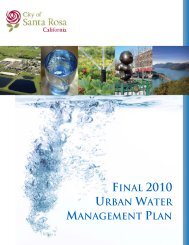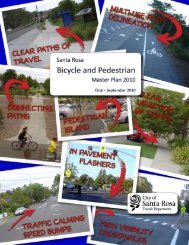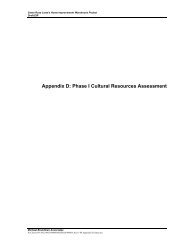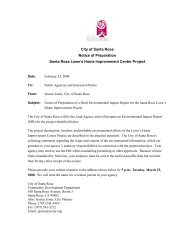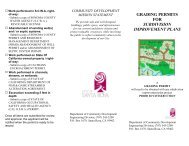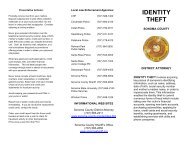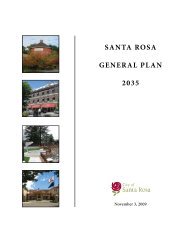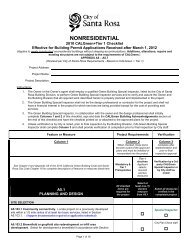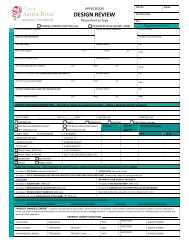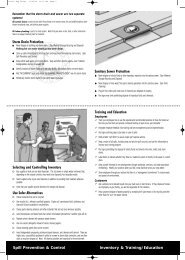Fountaingrove Environmental Impact Report - City of Santa Rosa ...
Fountaingrove Environmental Impact Report - City of Santa Rosa ...
Fountaingrove Environmental Impact Report - City of Santa Rosa ...
You also want an ePaper? Increase the reach of your titles
YUMPU automatically turns print PDFs into web optimized ePapers that Google loves.
ES082008001BAO_<strong>Fountaingrove</strong>_publicComments_v3.indd_090408_lho<br />
PUBLIC<br />
HEARING – 26<br />
PUBLIC<br />
HEARING – 27<br />
PUBLIC<br />
HEARING – 28<br />
PUBLIC<br />
HEARING – 29<br />
PUBLIC<br />
HEARING – 30<br />
PUBLIC<br />
HEARING – 31<br />
The reptiles, birds, and mammals which inhabit the woods are also slated for destruction.<br />
Lizards, frogs, snakes, turtles, deer, skunks, rabbits, foxes, squirrels, turkey, quails, hawks,<br />
vultures, crows, warblers, finches, mocking birds, blue birds, chickadees, and many more all<br />
will loose their foraging and nesting sites, and we will loose their presence among us<br />
forever. The report is cavalier to say the least regarding this loss.<br />
It tells us, for example, that no raptor has a high potential to occur or nest at this sight and<br />
only a few cooper’s hawks, white tail kites and long ear owls have moderate potential. But I<br />
have personally identified each <strong>of</strong> these species on my walks by the woods. Moderate<br />
potential, they are already there. The mitigation suggested for the lost nesting sites for<br />
raptors is to avoid construction activity during the breeding season March 1 - Sept 15, but<br />
that leaves only late fall and wet winter for heavy construction, so the report suggests an<br />
alternative, hire a biologist to find all active nests and create buffer zones to protect them.<br />
But given the narrow shape <strong>of</strong> the site, adequate buffer zones could completely halt<br />
construction. So the report <strong>of</strong>fers yet a third suggestion, simply cut down all the trees with<br />
nesting potential during the winter. No trees, no nest, problem solved.<br />
Suffice it to say that the Draft <strong>Report</strong> is woefully inadequate. At the very least this project<br />
requires significantly downsizing to salvage more <strong>of</strong> our irreplaceable heritage oaks and all<br />
the creatures that dwell among them.<br />
Abe Farkas<br />
I live at 4434 Bally Bunion Lane. The EIR report does not address <strong>Impact</strong>s 3.1-1 and 3.1.-2<br />
aesthetics visual resources in so far as this project calls for the construction <strong>of</strong> a 3 story<br />
building in a neighborhood that is comprised <strong>of</strong> only 2 story homes. The current height<br />
limits should be respected. The sheer 3 story height, let alone and the mass and size <strong>of</strong> these<br />
buildings, must have a substantial negative impact on the aesthetics <strong>of</strong> our neighborhood.<br />
Per page 2-7 <strong>of</strong> the report, the 3 story main building will rise to the height <strong>of</strong> 49 feet and may<br />
run to some 600 feet in length. Imagine such a structure being dropped into the residential<br />
neighborhood in where you live (shows photo) and then also imagine a 3 story care center<br />
building over looking your swimming pool and being told there will be no significant<br />
impact on your neighborhood aesthetics. Just imagine that.<br />
The report fails to adequately address <strong>Impact</strong> 3.10-2, noises from operating the building on<br />
adjacent property. The mitigation measure recommended is to place the mechanical<br />
equipment on the ro<strong>of</strong> <strong>of</strong> the buildings, yet the photos supplied in Figures 3.1-4 and 3.1-7<br />
clearly show sloped ro<strong>of</strong>s with no provisions for any mechanical equipment. Given the near<br />
50 foot height <strong>of</strong> the proposed building, in addition to the noise this will compound the<br />
negative impacts on the aesthetics that was to have been addressed in <strong>Impact</strong> 3.1. (shows<br />
photo) You cannot hardly see the brown ro<strong>of</strong> tops unless you are looking at the actual<br />
photo but they are clearly 30 feet or more up in the air, clearly visible.<br />
Next, this report fails to recognize the mitigation measure called for in <strong>Impact</strong> 3.4-1 loss <strong>of</strong><br />
protected heritage valley oaks is inadequate and also it does not protect our aesthetic and<br />
visual resources. Table 3.4-3 calls for 2,107 15 gallon replacement trees, while the data in the<br />
same report states that 45.8 percent <strong>of</strong> the total development site will be covered with<br />
improvements. Where will these thousands <strong>of</strong> trees go? I ask this question because the<br />
placement <strong>of</strong> the building is basically on the zero lot line with three feet or less from the



